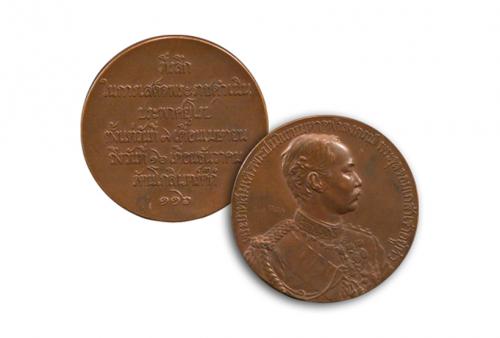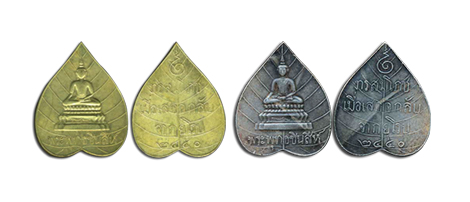When King Chulalongkorn or King Rama V came to the throne in 1868, Siam was in the period when reform based on western models was being introduced. Many roads and canals were built while the army and administration were also reorganized on modern lines as well as the introduction of standard of coinage to serve the growing economy.
Although only 16 when he ascended to the throne, King Chulalongkorn carried on with his father’s reform schemes and even initiated many other modernization and development programs for example, the construction of railways, the establishment of a Civil Service with many ministries and the restructuring of the legal code including the abolition of slavery. When His Majesty had an opportunity to visit India, Burma, Java and Malaya, he paid a special interest in the progress and development of these British and Dutch colonial countries especially in the areas of technologies and administrations. The visit inspired the King to want to learn more, this time from the parent countries themselves.
The reign of King Rama V also saw the threat of European colonialism with all the neighboring countries surrendering one by one to the western powers. To preserve the country’s independence, King Chulalongkorn had to yield to some unfair demands from Britain and France which included signing a number of unequal treaties, granting extraterritorial right to European citizens as well as having to cede several territories, for example, the Khmer provinces of Siem Reap, Battambang, and Sisophon were ceded to France in return for French withdrawal from Siam province of Chantaburi and the abandonment of French extraterritorial claims over their "protected persons”. Also, in return for judicial autonomy, Siam ceded the Malay states of Kedah, Perlis, Kelatan, and Trengganu to Britain. It was also mainly due to King Rama V’s great rule which united the country in harmony and as such a stable kingdom, both France and England agreed to maintain it as a buffer-state.
The determined will to enhance the modernization programs and the effort to put the country in a strong international position at the peak of the colonial threat were two major reasons for His Majesty to pay a state visit to the European countries. He was the first Thai King to ever travel to Europe. The royal trip to Europe started on 7 April 1897. His Majesty was in a full dress of the Army General with the Royal House of Chakri Decorations. He was accompanied by some royal members and courtiers and the group was on board the royal yacht "Maha Chakri” which left Bangkok at Rajavaradit Pier. The yacht sailed down to the Gulf of Thailand to Singapore, Colombo in Sri Lanka, Port Aden in the Middle East and then crossed the Suez canal to the Mediterranean Sea before arriving at the Adriatic sea.
On 14 May, His Majesty arrived in Venice, Italy. From here, he took the train to Milan and then traveled on to Switzerland, Austria and arrived in Hungary on 22 June where His Majesty was warmly welcomed by King Emperor Prince Josef I.
On 3 July, His Majesty arrived in Russia and stayed as the royal guest of the Emperor of Russia, Czar Nicholas II at Peterhof Palace for 8 days. His Majesty's close relationship with the Emperor of Russia occurred since Czar Nicholas II visited Siam as the Crown Prince and was very impressed by the warm welcome of His Majesty. From Russia, the royal group traveled by the "Maha Chakri” yacht through the Baltic Sea to Sweden, Denmark and arrived in England on 29 July. His Majesty was warmly welcomed by the Prince of Wales (Later King Edward VII), the Duke of Connaught and the Duke of York (later King George V) and stayed at Buckingham Palace. From London, His Majesty moved to Dover to take a steam launch to Ostend, Belgium and proceeded to Germany and arrived in Holland on 6 September. He stayed at Het Loo Palace as a royal guest of H.M. Emmn, Queen Regent and H.M. Wilhelmina, Queen of Holland. From Holland, His Majesty traveled by train to Belgium, Germany and France. Although, France and Siam had, at the time, a conflict over the frontiers along the Maekhong Bank, His Majesty was very warmly welcomed by the French people. Sitting beside the President of France in a horse - drawn carriage along the streets of Paris, the King received a hearty cheer from the crowd.
On 16 October, His Majesty arrived at Madrid and then back to Italy where this time, His Majesty visited Naples and Pompei which were the last two cities of Europe to visit in this trip.
On 2 November, His Majesty was back on board the Chakri Royal Ship to travel back to Bangkok. The group arrived back in Bangkok on 16 December 1897. The total time of this state visit to Europe was 9 months.
Ten years later, His Majesty King Chulalongkorn paid a second state visit to Europe. Both visits were a great success and beneficial to the country, not only bringing back novelties and technologies from these western countries, His Majesty also strengthened the cordial relationship with European Royalties and Heads of States while enhancing the prestige and status of Siam to a high standing especially at the height of the colonization period.
The first state visit to Europe of His Majesty was a very remarkable event and thus three medals were struck to mark the occasion. The first medal was struck by Monnaie de Paris It was round shaped and featured the effigy of King Rama V on the obverse with his name around the edge and the engraver ‘s name "Aug. Patey” above the King‘s left Shoulder. On the reverse, the medal showed the inscription "To Commemorate the Royal Tour of Europe from April 7 to December 16, Rattanasin Era 116”. The medal was struck in gold, silver and bronze. Around the outer edge of the medal, there is an inscription "Monnaie de Paris” and the type of metal. This medal was also found with a loop for being hung on a ribbon 3.5cm in width which was yellow with blue and red rim. It was bestowed by the King to male and female royal members and courtiers to be worn as decoration.
The second medal which was also bestowed as decoration is the Queen Medal. This medal was struck to mark the occasion that Queen Saowabha was appointed the Regent while His Majesty was absent from the Kingdom on his Europe tour. The medal was round in shape and was struck in silver. It bore on the obverse, the Queen‘s monogram. On the reverse was the recipient’s name with the legend "To bestow to” above and "R.S. 116" below. It was to be hung on a light blue ribbon 3.2cm in width.
The third medal was issued to celebrate the King’s return from his tour. The medal was struck in a shape of a Bodhi leaf without stem. On the obverse, the medal depicted the Buddha Jinasiha image with the inscription "Buddha Jinasiha” below. The reverse was the Unalom scroll with the inscription "To Celebrate the Royal Return from Europe, B.E.2440” below. It was struck in silver and bronze.
the medal depicted the Buddha Jinasiha image with the inscription "Buddha Jinasiha".
It can be said that the first visit to Europe of King Rama V was a successful strategy in strengthening Thailand’s position in the international arena. His Majesty King Rama V designed the trip with a visit to Russia before proceeding to England and France. The news about His Majesty King Rama V of Siam being a royal guest of Czar Nicholas II of Russia enhanced the status of Siam and in some ways made England and France look at Siam in a more respectable way. This was His Majesty’s policy of safeguarding Thai independence with a successful result. As a consequence, this made his visit a very important and significant event in Thai history. The coins and medals marking this event are thus precious records of this prestigious part of Thai history.
References
• Chaipichit Cheumongkol, ”Sadej Poh”,Klang Saup Publishing, Bangkok
• H.R.H. Prince Chula Chakrabongse. "Lords of Life”, 3rd Edition, DD Books, Bangkok, 1982
• Treasury Department "Medals of the Rattanakosin Era AD 1782-1982”, Victory Power Point Corp.,Ltd,198


